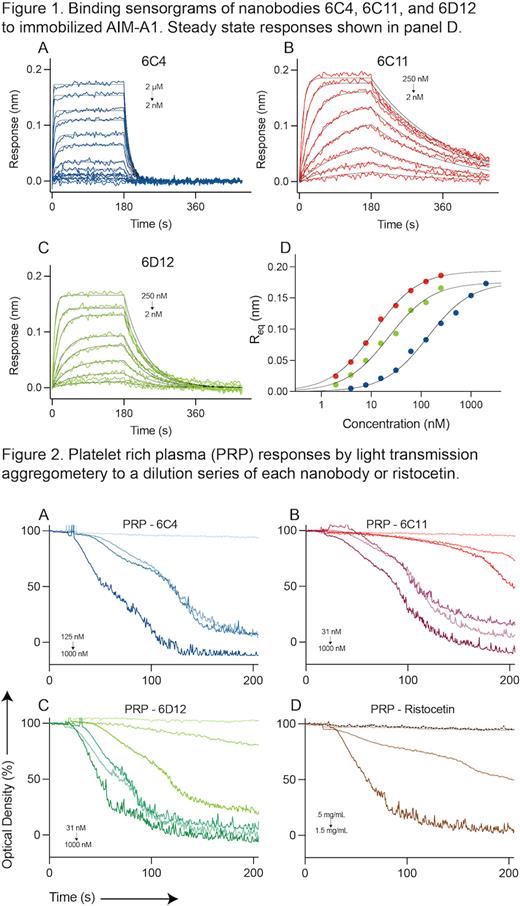Abstract
Introduction: Von Willebrand factor (VWF) is a multimeric plasma glycoprotein responsible for platelet arrest during injury, especially at high shear. After immobilization to the vessel wall, a VWF multimer is unfurled and elongated. This leads to exposure of the A1 domain therein that in turn binds to platelet receptor GPIbα and starts the aggregation process. Recently, it was suggested that VWF activation involves force-dependent disruption of the autoinhibitory module (AIM) that flanks the A1 domain on both sides. In this scenario, the AIM could be targeted for both VWF inhibition (Caplacizumab) and activation (ristocetin), although the exact mechanism and binding site of ristocetin still remains murky. If the quasi-stable structure of the AIM is important to VWF autoinhibition, specific disruption of its confirmation may be able to activate VWF. To this end, we sought to identify AIM-targeting activators using yeast surface display of a llama nanobody library.
Methods: One adult Lama glama was immunized with recombinant human VWF AIM-A1 protein produced from transfected Expi293F cells. VHH specific genes were amplified from cDNAs prepared from PBMCs of the animal and electroporated into EBY100 cells. The resulting yeast display library was screened for AIM-specific binders via selection against binding to recombinant A1 protein without an intact AIM, and then for binding to the complex of AIM-A1 with GPIbα. Positive hits were produced as His-tagged monomeric nanobodies in E. coli and purified with nickel-affinity and gel filtration chromatography. The affinity of nanobodies to AIM-A1 was determined using bio-layer interferometry. Platelet-rich plasma from healthy donors was used to assess the effect of nanobodies on platelet aggregation in a light transmission aggregometer with comparison to that of ristocetin.
Results: An AIM-A1-specific nanobody yeast display library was established. Several rounds of flow cytometry-based cell sorting of yeast cells with aforementioned binding properties produced AIM-binding nanobodies. Nanobodies encoded in three single clones have been expressed from E. coli and they exhibited differential binding affinities towards AIM-A1. Clone 6C4 showed the lowest affinity (K D 120 ± 3 nM), 6D12 showed intermediate affinity (K D 31 ± 0.8 nM), and 6C11 showed the highest affinity (K D 13.5 ± 0.2 nM) as shown in Figure 1. These nanobodies showed no detectable affinity towards recombinant A1-CAIM protein (residues 1268-1493), indicating that their epitopes are located in the N-terminal portion of the AIM (residues 1238-1267).
When added to human platelet-rich plasma, each nanobody dose-dependently activated platelets and rapidly induced full platelet aggregation at concentrations exceeding the affinity of the nanobody for VWF (Figure 2). The aggregation could be inhibited by the addition of antibodies that block the interaction between VWF and GPIbα. Plots of extents of aggregation as a function of nanobody concentration produced EC 50 values of ~100 nM for 6C11 and 6D12.
Conclusion: By isolating nanobodies that can bind specifically to the AIM and activate plasma VWF, we add supporting evidence that the AIM protects the A1 domain from binding to platelets. Interestingly, these nanobodies bind to the NAIM, on the opposite side of the module compared to ristocetin, the only known AIM-activating agent until now. With higher VWF-binding affinities than ristocetin and a robust profile as stable monomers, these nanobodies may prove useful in VWF-related research and diagnostics.
No relevant conflicts of interest to declare.


